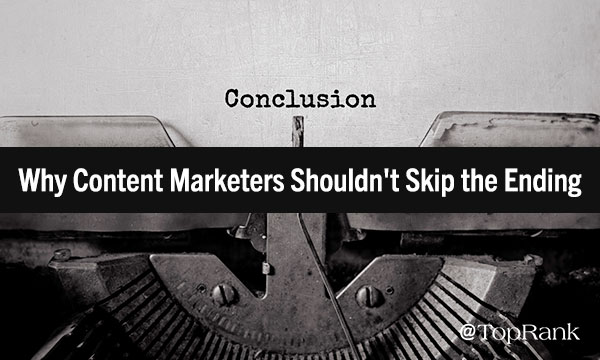Source: Online Marketing Blog – TopRank®

We marketing writers spend a lot of time crafting a piece of content. In fact, according to Orbit Media’s most recent blogger survey, most writers spend about three and half hours crafting one blog post—which is a one-hour jump from its first report in 2014, highlighting to me the focus on quality over quantity of output.
But let’s be honest, regardless of how long we spend on a piece of content, we have our priorities in terms of how we spend that time. The title, while just a few words, is how we grab audience attention or entice the click. The introduction is how we hook the readers. And, of course, the body is at the heart of it all where we make good on everything we’ve promised in the headline and introduction.
But when it comes to tying it all up with a solid conclusion, I’d argue that many of us aren’t giving that component the thought and care it deserves.
In today’s crowded content landscape and increasing numbness to marketing messages, we can’t afford to leave any opportunity for engagement, connection, and conversions on the table. So for me, conclusions shouldn’t be an afterthought, but rather an essential marketing storytelling element for three main reasons—which is something I detail in this little video shoot I did with TopRank Marketing President Susan Misukanis.
Take a peek at my video debut if you want the Cliff’s Notes, but I encourage you to keep reading to get more depth and examples that can inspire the next piece you craft.
3 Reasons Conclusions Deserve Content Marketing Care
#1 – Content consumption is bite-sized.
First of all, it’s no secret that humans have short attention spans. How short? Roughly 8 seconds. And in an age of so much content at our fingertips, so much content that is ready to be consumed—it’s overwhelming. As a result—whether we’re curious about a new trend, researching something we may need to purchase, professional development—we often scan or skim content to get satisfy our need for credible, quality content in the shortest amount of time.
All that said, there are absolutely moments when we’re willing to commit to diving deeper and give something our full attention—which brings me to my next point.
#2 – If we’ve done our jobs and we’ve enticed a reader to the end, we absolutely want to leave them with something of value.
At a minimum, you should be circling back to your main points to give your audience a great summary and then providing them with a next step. Depending on your industry, audience, topic and stage in the funnel, there’s a few different considerations here:
The Engagement Play
Keeping folks on-page and encouraging them to interact with the content. The easiest example here is asking a thought-provoking question that relates to the topic and gives readers a chance to lend their voice.
Here’s an example from my recent post regarding Facebook’s latest algorithm changes and what they meant for influencer marketing.
As you can read, there’s a summary, actionable next steps from a takeaway and other reading standpoint, and then a related question to encourage discussion.
Audience Team
The digital audience insights you need to build, manage and market to your digital audiences.

